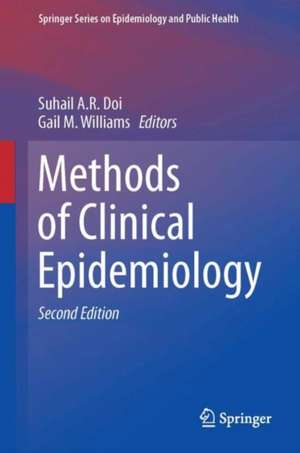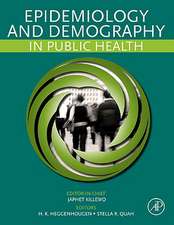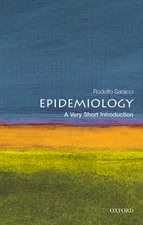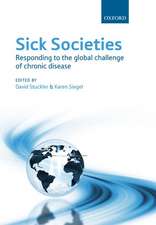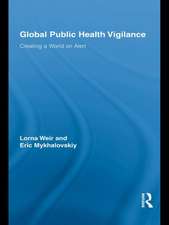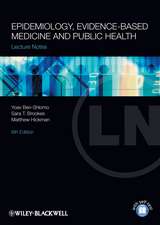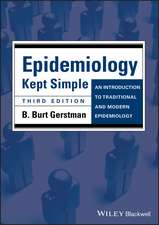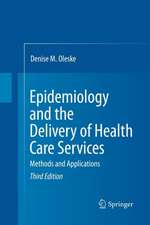Methods of Clinical Epidemiology: Springer Series on Epidemiology and Public Health
Editat de Suhail A. R. Doi, Gail M. Williamsen Limba Engleză Hardback – 14 iun 3000
This book provides an introduction to the common research methodology specific to clinical epidemiology for both students and researchers. The goal of the book is to fill the gap left by texts that concentrate on public health epidemiology and focuses on what is not covered well in such publications. The four sections of the book cover methods that have not previously been brought together in one volume and serve as a second level textbook of clinical epidemiology methods. Some of the most important topics included in this volume are: clinical agreement in quantitative measurements, interpretation of diagnostic tests, sample size considerations, modelling time-to-event data and meta-analysis. The book will be useful for clinical researchers as well as for postgraduate students in clinical epidemiology. In this second edition, sections related to modeling of binary outcomes and research synthesis methods have been extensively updated.
| Toate formatele și edițiile | Preț | Express |
|---|---|---|
| Paperback (1) | 715.91 lei 6-8 săpt. | |
| Springer Berlin, Heidelberg – 10 iul 2015 | 715.91 lei 6-8 săpt. | |
| Hardback (1) | 722.84 lei 6-8 săpt. | |
| Springer Berlin, Heidelberg – 12 iun 2013 | 722.84 lei 6-8 săpt. |
Preț: 566.96 lei
Preț vechi: 830.16 lei
-32% Nou
Puncte Express: 850
Preț estimativ în valută:
108.49€ • 116.01$ • 90.45£
108.49€ • 116.01$ • 90.45£
Carte nepublicată încă
Doresc să fiu notificat când acest titlu va fi disponibil:
Se trimite...
Preluare comenzi: 021 569.72.76
Specificații
ISBN-13: 9783319653334
ISBN-10: 3319653334
Pagini: 310
Ilustrații: Approx. 310 p. 48 illus., 4 illus. in color.
Dimensiuni: 155 x 235 mm
Ediția:2nd ed. 3000
Editura: Springer International Publishing
Colecția Springer
Seria Springer Series on Epidemiology and Public Health
Locul publicării:Cham, Switzerland
ISBN-10: 3319653334
Pagini: 310
Ilustrații: Approx. 310 p. 48 illus., 4 illus. in color.
Dimensiuni: 155 x 235 mm
Ediția:2nd ed. 3000
Editura: Springer International Publishing
Colecția Springer
Seria Springer Series on Epidemiology and Public Health
Locul publicării:Cham, Switzerland
Cuprins
Contents.- Contributors.- Table of Abbreviations.- Preface.- PART I: Clinical Agreement.- 1 Clinical Agreement in Qualitative Measurements.- 2 Clinical Agreement in Quantitative Measurements.- 3 Disagreement plots and the intra-class correlation in agreement studies.- 4 The Coefficient of Variation as an Index of Measurement Reliability.- PART II: Diagnostic Tests.- 5 Using and Interpreting Diagnostic Tests with Dichotomous or Polychotomous Results.- 6 Using and Interpreting Diagnostic Tests with Quantitative Results.- 7 Sample Size Considerations for Diagnostic Tests.- 8 An Introduction to Diagnostic Meta-analysis.- 9 Health Technology Assessments of Diagnostic Tests.- PART III: Modeling Binary and Time-To-Event Outcomes.- 10 Modelling Binary Outcomes.- 11 Modelling Time-to-event Data.- PART IV: Systematic Reviews and Meta-analysis.- 12 Systematic Reviewing.- 13 Quality Assessment in Meta-analysis.- 14 Meta-analysis I.- 15 Meta-analysis II.- Index.
Notă biografică
Suhail Doi is associate professor of clinical epidemiology at the University of Queensland. He is involved in teaching, student supervision, curriculum development and research. He has published widely and his interest lies in research that addresses unanswered questions in patient care as well as questions related to methods of research design and analysis used in medicine. Thus his research focuses on patient care topics such as epidemiology, prognosis and treatments of disease as well as methodology especially that related to meta-analysis. He is the co-author of the Doi–Thalib method for meta-analysis which was introduced in 2008 as an alternative to the random effects model.
Gail Williams is professor of international health statistics at the University of Queensland. She has had long involvement in curriculum development and teaching in graduate programs in biostatistics and epidemiology, as well as consulting in clinical medicine and public health. Her specific areas of expertise include design and analysis of longitudinal studies, clinical and field intervention trials, survey design, and mathematical modelling. The focus of her applied research has been maternal and child health, a range of infectious diseases, and skin cancer. Her methodological areas of interest lie in statistical and mathematical modelling and approaches to dealing with attrition in longitudinal studies.
Gail Williams is professor of international health statistics at the University of Queensland. She has had long involvement in curriculum development and teaching in graduate programs in biostatistics and epidemiology, as well as consulting in clinical medicine and public health. Her specific areas of expertise include design and analysis of longitudinal studies, clinical and field intervention trials, survey design, and mathematical modelling. The focus of her applied research has been maternal and child health, a range of infectious diseases, and skin cancer. Her methodological areas of interest lie in statistical and mathematical modelling and approaches to dealing with attrition in longitudinal studies.
Textul de pe ultima copertă
This book provides an introduction to the common research methodology specific to clinical epidemiology for both students and researchers. The goal of the book is to fill the gap left by texts that concentrate on public health epidemiology and focuses on what is not covered well in such publications. The four sections of the book cover methods that have not previously been brought together in one volume and serve as a second level textbook of clinical epidemiology methods. Some of the most important topics included in this volume are: clinical agreement in quantitative measurements, interpretation of diagnostic tests, sample size considerations, modelling time-to-event data and meta-analysis. The book will be useful for clinical researchers as well as for postgraduate students in clinical epidemiology. In this second edition, sections related to modeling of binary outcomes and research synthesis methods have been extensively updated.
Caracteristici
Provides a clear introduction to research methodology specific to clinical research Gives real life examples together with Stata codes Includes extensive material on modeling binary outcomes and research synthesis methods
Recenzii
“This is an excellent book on statistical and mathematical epidemiology as it applies to diagnostics and treatment outcomes of medical conditions. … Charts, tables, graphs, and equations are included throughout the discussions. … This is a good book for PH students and researchers.” (Joseph J. Grenier, Amazon.com, March, 2016)
